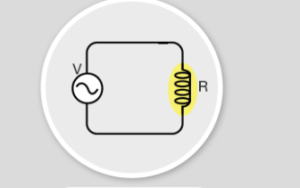Table of Contents
Impedance is equal to the product of resistance and reactance. It is defined as anything that prevents electrons from flowing through an electrical circuit. As a result, it influences the generation of current in the electrical circuit. It can be found in every possible circuit component and in every possible electrical circuit. The letter Z is used to represent impedance, and the ohm is its unit. It is the result of a combination of resistance and reactance. Impedance Z is described in phasor terms as a combination of resistance R and reactance X as:
X = R + j X
Where X denotes the sum of inductive XL and capacitive Xc reactances.
X = XL + Xc

Electrical impedance is a measurement of the total resistance to an electric current that a circuit or a portion of a circuit presents. Impedance includes both resistance and reactance. The resistance component is caused by collisions of current-carrying charged particles with the conductor’s internal structure. The reactance component is an additional opposition to the movement of electric charge caused by changing magnetic and electric fields in alternating current circuits. In circuits carrying constant direct current, impedance is reduced to resistance.
The magnitude of a circuit’s impedance Z is equal to the maximum potential difference across the circuit, or voltage, V (volts), divided by the maximum current I (amperes), or Z = V/I. The ohm is the unit of impedance, as it is of resistance. The alternating current either lags or leads the voltage depending on the nature of the reactance component of the impedance (whether predominantly inductive or capacitive). The admittance is defined as the reciprocal of the impedance, 1/Z, and is expressed in terms of the conductance unit, the mho unit (ohm spelt backwards).
Dimensional Formula of Impedance
Impedance’s dimensional formula is given by,
M1 L2 I-2 T-3
Where,
M stands for mass.
T = Time I = Current L = Length
Impedance (Z) = Voltage × [Electric Current]-1 . . . . (1)
Voltage = Electric Field × Distance
V = Force × [Electric Charge]-1 × Distance . . (2)
The force dimensions = [M1 L1 T-2] . . . (3)
Furthermore, the electric charge dimensional formula = [I1 T1] . . . (4)
Equations (3) and (4) are substituted into equation (2) to give
V = [M1 L1 T-2] × [I1 T1]-1 × [M0 L1 T0]
The voltage dimensional formula = [M1 L2 I-1 T-3] . . . . (5)
Furthermore, the dimensions of Electric Current = [M0 L0 I-1 T0] . . . . . (6)
We get by substituting equations (5) and (6) in equation (1).
Impedance = Voltage × [Electric Current]-1
Or, Z = [M1 L2 I-1 T-3] × [M0 L0 I1 T0]-1 = [M1 L2 I-2 T-3]
As a result, impedance is represented dimensionally as M1 L2 I-2 T-3.
FAQs
What is the Use of Impedance?
Impedance is applicable to our own home. The fuses panel regulates the electricity in the area. When the power surges, the fuses trip, reducing the number of electrical accidents. Fuses are similar to high capacity resistors that take the brunt of the damage. Furthermore, impedance in capacitors handles this situation. The electricity delivered by the alternating current is in the form of a fluctuating pulse. As a result, it is necessary to regulate the electricity flowing smoothly in the electric circuit—capacitor. The flow of electricity in a circuit board is managed by impedance. Electrical appliances that use alternating current will burn if capacitors are not used to regulate the electrical discharge.
What factors contribute to impedance?
The resistance in the image is caused by electron collisions with atoms inside the resistors. The creation of an electric field causes impedance in a capacitor. The creation of a magnetic field causes impedance in an inductor.

